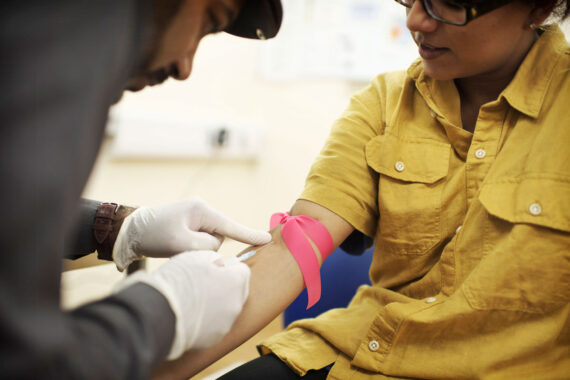Rare diseases and the role of primary care


In the latest in our series from Pulse Live talks, GP and genetic expert Dr Will Evans discusses how GPs can help spot rare diseases
A disease is classified as rare if it affects fewer than 1 in 2,000 people. There are more than 8,000 such diseases, giving a combined prevalence of 3.5%-5.9%. The majority (72%) are genetic and 70% have symptom onset in childhood.1
Why are rare diseases important in primary care?
Although rare diseases are often considered the realm of hospital specialists, primary care has a vital role in the identification, management and support of affected patients and their families. The understandable question of ‘how can I ever know all these diseases?’ can be addressed by getting to know their effects and understanding that although such diseases may differ, many share similar problems.
Primary care’s role in diagnosis
Patients frequently spend years, even decades, trying to get an accurate diagnosis. This ‘diagnostic odyssey’ involves a game of medical ping pong, with patients passed between different specialties and investigations.
An accurate diagnosis is hugely beneficial. It ends the odyssey, gives patients an explanation and validation for their problems, and offers a diagnostic label that can help to access educational and social support. Even if there is no cure, the diagnosis enables specialist care and optimised management, allowing patients to access support from patient advocacy groups as well as potential access to trials and emerging therapies.
When should you consider a rare disease?
Although with more than 8,000 diseases there are too many to know them all, we are well placed to identify patients who may have a rare disease. We are generalists and have access to a clinical record that continues over the life of our patients, enabling us to join the dots across the biology and chronology of their medical history, picking up patterns missed by our single organ system-focused secondary care colleagues.2
Thinking ‘is there a more plausible explanation for my patient’s problems?’ is a key first step. For example, asking why a patient has a learning difficulty, epilepsy and a cardiac problem? Simply considering rare diseases and following our ‘gut feeling’ when patterns of clinical features don’t fit, can be invaluable to these patients.3 ‘Family GENES’ (see box) is a helpful mnemonic to frame your suspicions, with online rare disease search engines, such as findzebra, useful to refine differential diagnoses.
Many patients may have had their ‘diagnostic window’ when they first presented to paediatric services. However, there have been significant advances in testing, especially in genomics. Whole-genome sequencing is now a ‘routinely available’ test in the NHS. So an important question is, when should we consider further testing and referral for these patients, many of whom are now young adults previously investigated but now discharged to primary care for symptomatic management? There is no definitive answer but understanding the wishes of the patient and their family, and liaising with secondary care colleagues including possibly clinical genetics can help clarify things.
Family GENES: When to suspect a rare or genetic disease in primary care
Family history: taking a three-generation family history can highlight inherited conditions. Are there multiple affected siblings, or affected individuals across the generations? NB, the absence of a family history does NOT rule out a genetic cause.
- Groups of congenital anomalies. Common anatomic variations are common but two or more anomalies are much more likely to indicate the presence of a syndrome.
- Extreme or exceptional presentation of common conditions. Early-onset cardiovascular disease, cancer or renal failure. Unusually severe reaction to infectious or metabolic stress. Recurrent miscarriage.
- Neurodevelopmental delay or degeneration. Developmental delay in the paediatric age group carries a very high risk for genetic disorders. Developmental regression in children or early-onset dementia in adults should similarly raise suspicion for genetic etiologies.
- Extreme or exceptional pathology.
- Surprising laboratory values.
Primary care’s role in management
The care of patients with rare disease is often complex, involving multiple specialists at distant specialist centres. Specialist centre involvement has a huge positive impact for patients, improving care and access to emerging therapies and trials. However, this can mean that, apart from the patient and their family, who are frequently experts in their disease, there may be little local knowledge or healthcare input. For these patients GPs play an important role in helping navigate local health and social services. For many rare diseases there is no specialist centre and the role of GP as care co-ordinator, especially for adults with, can be invaluable.
Simple strategies can make a huge difference. Emergency care plans, patient summaries and key letters highlighted on the patient’s EHR home page can help you and your out-of-hours colleagues.
Take care to avoid diagnostic overshadowing – the assumption that every problem is a consequence of the ‘headline’ diagnosis. Common diseases and infections happen too. Addressing issues such as urinary retention, constipation or depression can make a big difference to patients and often improves their apparent disease severity.
Don’t assume others have thought about and addressed simple things. Things that are often missed include suitable home adjustments, which can be assesed by an occupational therapist.
Use existing opportunities, such as learning disability reviews, to ensure disease/syndrome- specific healthcare issues are considered and addressed. Think about the patient and their wider family: are there reproductive issues, is a referral for genetic counselling appropriate?
Key points
- Rare diseases are individually rare but collectively common.
- Dare to think rare. Is there a more plausible explanation for your patient’s problems?
- Use online resources and local experts and clinicians to refine your suspicions.
- Primary care plays a key role in the day-to-day management, as well as communicating and advocating for patients.
- Work collaboratively with rare disease patients. They are often experts in their disease and how it affects them.
- Avoid ‘diagnostic overshadowing’ and don’t underestimate the impact of good generalist care for the patient and their family.
Dr Will Evans is a GP in Leeds, GPwSI in clinical genetics, and clinical assistant professor at the University of Nottingham
References
- Nguengang Wakap S et al. Estimating cumulative point prevalence of rare diseases: analysis of the Orphanet database. Eur J Hum Genet 2020,28(2),165–73. Link
- Evans W and Rafi I. Rare diseases in general practice: recognising the zebras among the horses. BJGP2016,66:550-1. Link
- de Vries E et al. Preventing gatekeeping delays in the diagnosis of rare diseases. BJGP 2018,68,145-6. Link
- Whelan A et al. Genetic red flags: clues to thinking genetically in primary care practice. Prim Care 2004 31(3)497–508. Link

Pulse 365 LIVE Events cover a broad array of topics pertinent to you, your patients, and your practice. You will gain free CPD and be able to take part in live Q&As. Specifically created for all practising, GMC-registered GPs and trainees, you will hear from experts across primary and secondary care, and network with like-minded GPs. Sign up for your nearest event today.
Pulse July survey
Take our July 2025 survey to potentially win £1.000 worth of tokens

Visit Pulse Reference for details on 140 symptoms, including easily searchable symptoms and categories, offering you a free platform to check symptoms and receive potential diagnoses during consultations.
Related Articles
READERS' COMMENTS [1]
Please note, only GPs are permitted to add comments to articles












Thank you Dr Evans this was an amazing article that demistifies this area of medicine.
Kind regards